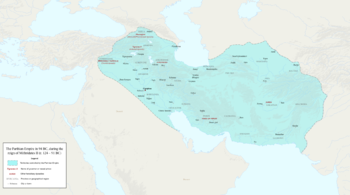Difference between revisions of "Parthians"
| Line 1: | Line 1: | ||
[[File:Parthian Empire. | [[File:Parthian Empire.png|thumb|350px]] | ||
The '''Parthian Empire''', also known as the Arsacid Empire, was a major Iranian political and cultural power in ancient Iran from 247 BC to 224 AD. | The '''Parthian Empire''', also known as the Arsacid Empire, was a major Iranian political and cultural power in ancient Iran from 247 BC to 224 AD. | ||
Revision as of 12:24, 17 February 2021
The Parthian Empire, also known as the Arsacid Empire, was a major Iranian political and cultural power in ancient Iran from 247 BC to 224 AD.
Overview
The Parthian Empire was founded by King Arsaces I, who led the Parni tribe in conquering the region of Parthia in Iran's northeast, then a satrapy (province) under Andragoras, in rebellion against the Seleucid Empire. Mithridates I (r. c. 171–132 BC) greatly expanded the empire by seizing Media and Mesopotamia from the Seleucids. At its height, the Parthian Empire stretched from the northern reaches of the Euphrates, in what is now central-eastern Turkey, to present-day Afghanistan and western Pakistan. The empire, located on the Silk Road trade route between the Roman Empire in the Mediterranean Basin and the Han dynasty of China, became a center of trade and commerce.
The Parthians largely adopted the art, architecture, religious beliefs, and royal insignia of their culturally heterogeneous empire, which encompassed Persian, Hellenistic, and regional cultures. The Arsacid rulers were titled the "King of Kings", as a claim to be the heirs to the Achaemenid Empire; indeed, they accepted many local kings as vassals where the Achaemenids would have had centrally appointed, albeit largely autonomous, satraps. The court did appoint a small number of satraps, largely outside Iran, but these satrapies were smaller and less powerful than the Achaemenid potentates. With the expansion of Arsacid power, the seat of central government shifted from Nisa to Ctesiphon along the Tigris (south of modern Baghdad, Iraq), although several other sites also served as capitals.
The earliest enemies of the Parthians were the Seleucids in the west and the Scythians in the north. However, as Parthia expanded westward, they came into conflict with the Kingdom of Armenia, and eventually the late Roman Republic. Rome and Parthia competed with each other to establish the kings of Armenia as their subordinate clients. The Parthians destroyed the army of Marcus Licinius Crassus at the Battle of Carrhae in 53 BC, and in 40–39 BC, Parthian forces captured the whole of the Levant except Tyre from the Romans. However, Mark Antony led a counterattack against Parthia, although his successes were generally achieved in his absence, under the leadership of his lieutenant Ventidius. Various Roman emperors or their appointed generals invaded Mesopotamia in the course of the ensuing Roman–Parthian Wars of the next few centuries. The Romans captured the cities of Seleucia and Ctesiphon on multiple occasions during these conflicts, but were never able to hold on to them.
The Parthian power evaporated when Ardashir I, ruler of Istakhr in Persis, revolted against the Arsacids and killed their last ruler, Artabanus IV, in 224 AD. Ardashir established the Sasanian Empire, which ruled Iran and much of the Near East until the Muslim conquests of the 7th century AD.
